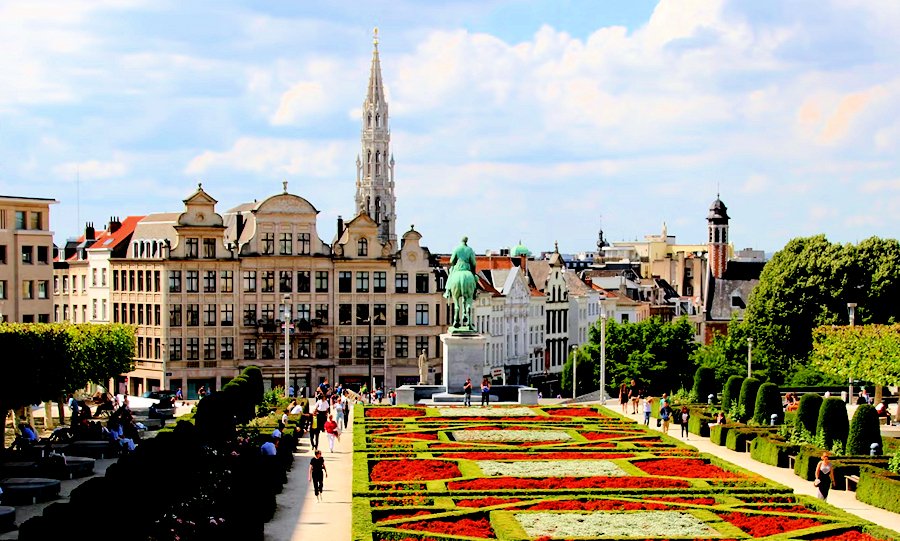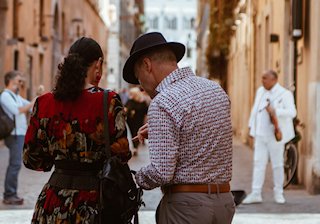Travel Notes: Destinations: Europe: Belgium - Brussels Travel Guide.
Short URL: https://tnot.es/BRU
Travel Guide For Visitors to Brussels
Discover the best of Brussels from iconic landmarks and hidden gems to delicious Belgian cuisine and vibrant culture. Plan your Brussels visit with insider tips. Share on Facebook
They Say Brussels is Boring
Forget everything you think you know about Brussels being boring; this compact European capital is about to surprise you with its quirky charm, world-class food scene, and fascinating blend of old-world elegance and modern mayhem.
Driving Distances in Europe
 Add a Business -
Add a Location -
Add a Lodging - Add Travel Content
- Add URL
- Travel Services.
Add a Business -
Add a Location -
Add a Lodging - Add Travel Content
- Add URL
- Travel Services.
Making The Most of a Visit to Brussels
Brussels gets a bit of a rough deal in the travel world, often dismissed as just another stuffy EU headquarters.
But spend even a weekend here, and you'll discover a city that's refreshingly unpretentious, deliciously indulgent, and packed with more character than you'd expect from somewhere you can walk across in under an hour.
This is a place where centuries-old guild houses share cobbled squares with contemporary street art, where you can hunt for vintage treasures in morning markets before diving into some of Europe's best beer culture come evening.
Plus, with trains whisking you here from London in just over three hours, Brussels makes for an ideal European getaway that won't break the bank.
Getting to Brussels - Your Travel Options
Flying to Brussels
Brussels Airport (BRU) sits about 12km north-east of the city centre, with direct flights from major UK airports taking roughly 1.5 hours.
The Airport Express train runs every 15 minutes to Brussels Central Station, making it dead simple to reach the heart of the city.
Taking the Train via Eurostar
The Eurostar from London St Pancras to Brussels Midi takes 3 hours 20 minutes, dropping you right in the city centre.
Book in advance for the best deals; you can often snag return tickets for under £100 if you are flexible with dates.
Driving to Brussels
If you're planning a longer European adventure, Brussels sits perfectly positioned for exploring neighbouring countries.
The city has decent parking, though the medieval centre can be tricky to navigate.
Expect about four to five hours from Calais.
Brussels Attractions - What to See and Do
Atomium - Brussels' Space Age Icon
This 1958 World's Fair leftover might look like a giant molecular model, but it's become Brussels' most recognisable landmark.
The views from the top sphere are spectacular, and the exhibitions inside explore mid-20th century optimism about science and progress.
Comic Strip Trail
Belgium gave the world Tintin, the Smurfs, and countless other comic heroes.
Follow the outdoor comic strip murals scattered throughout the city; there are over 50 to discover, turning a simple walk into a treasure hunt.
European Quarter
Love it or loathe it, the EU institutions are part of Brussels' identity.
The Parliament offers free tours (book ahead), and the area's modern architecture provides an interesting contrast to the historic centre.
Grand Place - Europe's Most Beautiful Square
UNESCO wasn't messing about when they declared Brussels' Grand Place a World Heritage site.
This 13th-century square, ringed by ornate guild houses and the imposing Town Hall, genuinely takes your breath away; especially when lit up at night.
Visit early morning or evening to avoid the crowds and get the best photos.
Royal Museums of Fine Arts
Art lovers shouldn't miss this collection spanning six centuries, from Flemish primitives to contemporary works.
The Magritte Museum, dedicated to Belgium's most famous surrealist, deserves particular attention.
Allow at least half a day to do it justice.
Brussels Food and Drink - A Culinary Adventure
Belgian Beer Culture
With over 3,000 different beers, Belgium takes brewing seriously.
Start with classics like Chimay, Orval, or Westvleteren, then explore local Brussels breweries.
Delirium Café holds the Guinness World Record for most beers available (over 3,000), while Cantillon offers fascinating tours of their traditional lambic brewery.
Chocolate Heaven
Forget Swiss chocolate; Belgium does it better.
Pierre Marcolini, Laurent Gerbaud, and Wittamer represent the artisanal end, while Leonidas and Godiva offer quality at more accessible prices.
The Museum of Cocoa and Chocolate provides sweet education with plenty of tasting opportunities.
Moules-Frites and More
The classic mussels and chips combo reaches perfection at traditional brasseries like Chez Leon or Aux Armes de Bruxelles.
For something different, try carbonnade flamande (beef stewed in beer) or waterzooi (creamy chicken or fish stew).
Waffle Wisdom
Tourist spots serve mediocre waffles, but hunt down authentic versions at local cafés.
Brussels waffles are light and rectangular with deep pockets perfect for catching syrup, while Liège waffles are denser and sweeter with caramelised sugar chunks.
Where to Stay in Brussels - Best Areas for Tourists
Grand Place and City Centre
The obvious choice for first-time visitors, staying near the Grand Place puts you within walking distance of major attractions.
Hotels here range from boutique properties in converted guild houses to modern chains, though expect to pay premium prices for the prime location.
Ixelles and Flagey
Perfect for longer stays, these areas feel more like real Brussels rather than tourist central.
Great restaurants, local markets, and significantly better value accommodation make this worth considering.
Sainte-Catherine District
This trendy neighbourhood offers excellent value with a brilliant food scene.
The old fish market area has transformed into a foodie paradise, and you're still only a 10-minute walk from the main sights.
Tourist Map of Brussels
Use the Tourist Map of Brussels to help you decide where to stay in Brussels based on travel budget, preferred location, planned must-see attractions and local must-do activities.
Brussels Shopping - From Markets to Boutiques
Galeries Royales Saint-Hubert
These beautiful 19th-century shopping arcades house luxury boutiques, chocolate shops, and traditional cafés.
Even if you're not buying, the architecture alone makes it worth a wander.
Markets Worth Visiting
The Sablon Antiques Market (weekends) offers everything from vintage posters to genuine antiques.
Marché du Midi (Sunday mornings) is Brussels' largest market, brilliant for fresh produce and people-watching.
Vintage and Alternative Shopping
The Marolles district offers the best vintage hunting, with quirky shops and the daily flea market at Place du Jeu de Balle.
Rue Dansaert provides contemporary Belgian fashion and design.
Getting Around Brussels
Cycling in Brussels
The city has improved cycling infrastructure recently, with bike-sharing schemes and dedicated lanes.
However, Brussels' hills and cobblestone streets can be challenging for casual cyclists.
Public Transport
Brussels' metro, trams, and buses use an integrated ticketing system.
The metro covers key areas, while trams are perfect for reaching outlying attractions.
Day passes (€8) offer good value if you're making multiple journeys.
Walking Brussels
The city centre is compact enough to explore on foot; you can walk from the Grand Place to most major attractions within 20 minutes.
The medieval layout means streets don't follow logical patterns, so download offline maps or grab a paper version.
Brussels Weather - When to Visit
Best Time to Visit Brussels
May through September offers the most pleasant weather, with longer days and outdoor café season in full swing.
July and August see the most tourists and highest prices.
Shoulder Season Benefits
April and October provide excellent value with fewer crowds.
The weather might be unpredictable, but you'll experience Brussels more like locals do; and many attractions offer reduced admission.
Winter in Brussels
December brings Christmas markets and festive atmosphere, though expect shorter days and frequent rain.
Pack layers and waterproof clothing regardless of season.
Brussels with Kids - Family-Friendly Activities
Kid-Friendly Attractions
The Natural Sciences Museum houses impressive dinosaur skeletons, while the Toy Museum showcases playthings from different eras.
The Atomium fascinates children with its space-age design and interactive exhibits.
Family Dining
Many restaurants welcome families, and Belgian cuisine appeals to young palates; chips, chocolate, and waffles rarely disappoint.
Look for restaurants with 'Menu Enfant' options.
Budget Tips for Brussels
Free Activities
Many of Brussels' best experiences cost nothing; wandering the Grand Place, following the comic strip trail, or exploring the Marolles district.
Several museums offer free entry on the first Sunday of each month.
Money-Saving Strategies
The Brussels Card provides free public transport and museum entry, though calculate whether it offers genuine savings based on your plans.
Supermarket chains like Delhaize and Carrefour sell excellent Belgian chocolate at a fraction of tourist shop prices.
Where to Eat Affordably
University areas offer great value dining, while food trucks and casual eateries provide tasty alternatives to tourist restaurants.
Many cafés serve generous portions that easily satisfy two people.
Brussels Nightlife and Entertainment
Beer Bars and Pubs
Brussels' café culture extends well into the evening, with traditional brown cafés serving hundreds of different beers.
The Delirium Village (near Grand Place) offers multiple bars under one roof, while locals favour neighbourhood spots in Ixelles or Saint-Gilles.
Cultural Events
The Palais des Beaux-Arts hosts classical concerts and contemporary performances, while smaller venues like AB (Ancienne Belgique) showcase emerging musicians.
Check local listings for temporary exhibitions and festivals.
Day Trips from Brussels
Antwerp
Antwerp, Belgium's second city, deserves at least a day trip for its impressive cathedral, diamond district, and vibrant fashion scene.
Regular trains make the journey in under an hour.
Bruges and Ghent
Both medieval gems sit within an hour by train from Brussels.
Bruges offers fairy-tale canals and chocolate shops, while Ghent provides similar beauty with fewer tourists and better value.
Leuven
This university town offers beautiful architecture, excellent beer culture, and a fraction of the tourist crowds.
Perfect for experiencing authentic Belgian life.
Practical Brussels Travel Tips
Language in Brussels
Brussels is officially bilingual (French and Dutch), but English is widely spoken in tourist areas.
Learning basic French phrases helps, as it's more commonly used than Dutch in the city centre.
Safety in Brussels
Brussels is generally safe for tourists, though standard city precautions apply.
The areas around Brussels Midi station can feel sketchy after dark, while the city centre and tourist districts rarely present problems.
Tipping and Customs
Service charges are included in restaurant bills, though rounding up or leaving 5-10% for excellent service is appreciated.
Shops typically close on Sundays, and many restaurants close Monday evenings.
Making the Most of Your Visit to Brussels
Brussels rewards curious travellers who dig beneath the surface.
Yes, it's the EU capital, but it's also a city where locals argue passionately about the best fritkot (chip shop), where street art transforms boring buildings into canvases, and where you can discover your new favourite beer in a café that's been serving locals for centuries.
Don't rush through Brussels as a day trip between other European capitals; give it the time it deserves.
This is a city that reveals its secrets gradually, rewarding those who take time to explore its neighbourhoods, taste its specialities, and appreciate its unique blend of international sophistication and local character.
Whether you're here for a weekend break or using Brussels as a base for exploring Belgium, you'll find a city that's far more interesting, welcoming, and downright enjoyable than its reputation suggests.
Sometimes the best discoveries are hiding in plain sight.
More City Travel Guides
City Guides: Cities in Africa - Cities in America - Cities in Asia - Cities in Australasia - Cities in Latin America - European Cities and Regions.
More From Travel Notes
Travel Notes Online Guide to Travel
Africa - Asia - Caribbean - Europe - Middle East - North America - Oceania - South America.
The Travel Notes Online Guide to Travel helps visitors plan their trip with country and city travel guides, local tourist information, reviewed web sites, and inspiring travel content.
Travel and Tourism Guides on Travel Notes
 If you find Travel Notes useful, please take a moment to
like us on Facebook and share with your friends on social media.
If you find Travel Notes useful, please take a moment to
like us on Facebook and share with your friends on social media.
Share on Facebook
Travel Resources
.
Travel & Tourism With Industry Professionals.















